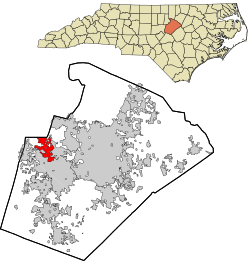Morrisville, North Carolina | |
|---|---|
Morrisville town limit sign Page House Pugh House Lake Crabtree Church Street Park | |
| Motto: "Live Connected. Live Well." | |
 Location in Wake County and the state of North Carolina. | |
| Coordinates: 35°48′57″N78°50′21″W / 35.81583°N 78.83917°W | |
| Country | |
| State | |
| Counties | Wake, Durham |
| Founded | 1852 |
| Incorporated | March 3, 1875 |
| Government | |
| • Type | Council-manager government |
| • Body | Morrisville Town Council |
| • Mayor | T.J. Cawley (Ind.) |
| Area | |
• Total | 8.89 sq mi (23.02 km2) |
| • Land | 8.83 sq mi (22.86 km2) |
| • Water | 0.062 sq mi (0.16 km2) |
| Elevation | 299 ft (91 m) |
| Population (2020) | |
• Total | 29,630 |
| • Density | 3,360/sq mi (1,296/km2) |
| Time zone | UTC−5 (Eastern (EST)) |
| • Summer (DST) | UTC−4 (EDT) |
| ZIP codes | 27519, 27560 |
| Area code(s) | 919 & 984 |
| FIPS code | 37-44520 [3] |
| GNIS feature ID | 2406198 [2] |
| Website | morrisvillenc |
Morrisville is a town located primarily in Wake County, North Carolina, United States (a small portion extends into neighboring Durham County). [4] [5] According to the 2020 census, the population was 29,630. [6] Morrisville is part of the Research Triangle metropolitan region, located midway between the cities of Raleigh and Durham. The Research Triangle region encompasses the Raleigh-Durham-Cary, NC Combined Statistical Area. The operational headquarters of Lenovo is located in the municipal limits.












